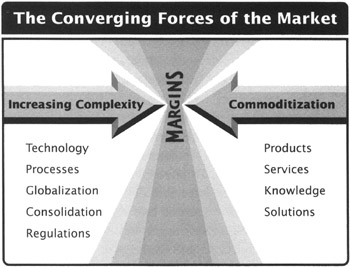
|


|
Chapter 1: The World in Which We Sell
Overview
Converging Forces of Rapid Commoditization and Increasing Complexity
Survival in today's sophisticated marketplace requires us to overcome two opposing forces: (1) increasing complexity and (2) rapid commoditization, the pressure from buyers to devalue the differences between goods and services and reduce their decision to the lowest common denominator - the selling price (see Figure 1.1). Let's be direct: The world in which we sell is being pulled apart by these two opposing forces. Even our most enterprise solutions are at the mercy of commoditization as our customers, swimming in a haze of confusion and performance pressure, grapple with tough decisions impacting their responsibilities. The net effect is a deadly spiral of shrinking profit margins.
Seeking competitive differentiation through increasing uniqueness and complexity is a deadly double-edged sword. These competitive advantages rapidly erode as they surpass the customers' level of comprehension. As this occurs, the overwhelming tendency of the customer is to treat all solutions the same - as a commodity.
With a true commodity, price and total transaction cost are the driving forces in the marketplace. As commoditization occurs, sales skills become less and less effective and transactional efficiency becomes the critical edge. The professional salesforce itself soon becomes a luxury that is too expensive to maintain. If your company has chosen to embrace commoditization as a dedicated strategy, it is - or soon will be - pursuing the lowest transactional cost it can achieve, and a book on sales process and skills will not be of much value.
When there is increasing complexity, sophistication, innovation, and value realized are the driving forces in the marketplace. To survive, a company is required to recruit and equip sales professionals who are capable of understanding the diverse situations their customers face, configuring the enterprise solutions offered by their companies, and managing the multifaceted relationships that are required to bring them both together. In short, the ability to create value for customers and capture value for companies is the key. Thus, the good news is that the future of the sales profession is secure in the multidimensional environment. The bad news is that as your company brings increasingly sophisticated offerings to the marketplace, your customers are being left confused. They are less and less able to understand the situations they face and evaluate these enterprise solutions, which tends to limit their decision-making criteria to the simplest elements of your offering, the lowest common denominators - price and specifications. If complexity accurately characterizes your selling environment, this resource is for you.
The impact of the complexity challenge is apparent in a wide range of industries including as examples professional and financial services, software, medical devices and equipment, IT solutions, or manufacturing systems. The people who serve these industries sell enterprise solutions with individual values that range from tens of thousands of dollars to tens of millions of dollars. Sales professionals serving these sectors are highly educated, very sophisticated, and definitely street-smart. And they are well paid. They are levels above the stereotypic image of salespeople that is imprinted on the public imagination.
Even though these professionals are masters of their crafts, a common lament is their frustration at a not unusual outcome of their efforts; one we will label the Dry Run. The generic version goes like this:
A prospective customer contacts your company with a problem that your solutions are expressly designed to address. A salesperson or team is assigned the account. The customer is qualified, appointments are set, and your sales team interviews the customer's team to determine what they want, what their requirements are, and what they plan to invest. A well-crafted, multimedia presentation is created, a complete solution within the customer's budget is proposed, and all the customer's likely questions are answered. Everyone on the customer's side of the table smiles and nods at the conclusion of the formal proposal. Everything makes good business sense. Your solution fills the customer's needs. You believe the sale is "in the bag," but the decision to move forward never comes. The result after weeks, months, and, sometimes, years of work: no sale. The customer doesn't buy from your company and often doesn't buy from your competitors. The worst-case scenario ends in what we refer to as unpaid consulting. The customer takes your solution design, shops it down the street, and does the work themselves or buys from a competitor. Many times, the customer simply doesn't take action on a solution that it needs and can afford. This, with a twist here and there, is the Dry Run. Sure, it's great practice and it's great experience, but this isn't a training exercise. This is the real world of selling, and, in this world, it's your job to bring in the business.
What's going on in this story? The sales team is doing everything it has been taught, but the result is not what is expected. In the diverse environment, the outcome of the conventional sales process is increasingly random and unpredictable. Some of the reasons behind this dilemma have been hinted at but to truly understand the situation, we examine the nature of the enterprise sale itself.
The topics covered herein concern solution sales, consultative sales, and consultative selling.

|


|
